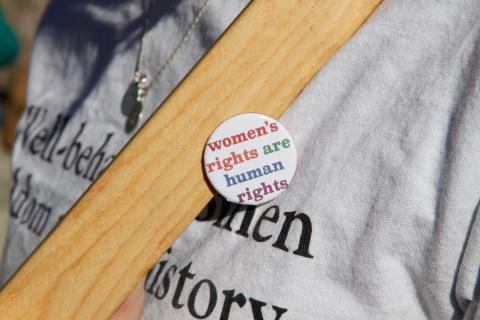The paradox of womanhood in Ohio

Listen to this Episode
Women in Ohio hold most of the state’s college degrees, but they’re also more likely than men to live in poverty and less likely to hold public office.
These are just a few of the findings in a recent report from the Center for Community Solutions.
The nonprofit think tank released fact sheets on the status of women in all 88 Ohio counties, examining factors like access to maternal health care, girls’ high school graduation rates and labor force participation.
Progress for women
Angela Maher, one of the researchers who helped compile the data, said the fact sheets highlighted just how much progress Ohio women have made in recent years.
“Young women are consistently graduating high school at higher rates than boys in almost every county,” she said. “Women also, almost across the board in counties, have more degrees than men, and this is for associate, bachelor’s, master’s and advanced degrees.
“The fact that that was so consistent and pervasive around the state was a surprise,” she said.
Other notable advancements for women include:
- Ohio women are more likely than men to be registered to vote and to cast a ballot in elections.
- More than 90% of women have health insurance in most Ohio counties, a big increase that came in the wake of the implementation of the Affordable Care Act and Medicaid expansions.
- In almost every Ohio county, births to teen mothers are declining, which increases the likelihood that a girl will graduate high school, and, in turn, increases job opportunities down the line.
- Ohio mothers work at higher rates than the national average.
Areas for improvement
Still, Maher said there’s a lot of work to be done for women to reach parity with Ohio’s men.
Despite their higher levels of educational attainment, for example, women in the state continue to earn less money than men.
“There is still a wage gap in every county in the state,” Maher said. “And this is in every industry and in every county. There isn't a single industry where it's reversed.”
In turn, the analysis found that women are more likely than men to live in poverty. And poverty rates are even higher for women with children.
Just about a third of all Ohio households are headed by women, Maher said, “but of households in poverty, 59% are headed by females.”
Other areas for improvement include:
- Despite voting at higher rates than men, women are less likely to hold public office in Ohio.
- Female high school students in Ohio report more mental health concerns like depression and anxiety, but the state’s public mental health service treats more boys.
- More than a dozen Ohio counties are maternity care deserts, according to the fact sheets. That means they don’t have hospitals or birth centers that provide obstetric care.
- Older women in Ohio are more likely than men to live alone, partly because they tend to live longer. They’re also much more likely than men to be caregivers for other adults.
What can be done?
Maher said the fact sheets are designed for local policy makers and community partners to track how their county is doing in relation to the rest of the state.
But it’s hard to say which counties are doing best and which are lagging behind.
“There are so many indicators included in these fact sheets,” Maher said, “it really varies depending on what you’re looking at.”
On a broader level, she said, there are steps the state can take to help women continue to advance.
In fact, it recently took one: allowing doulas to be covered by Medicaid.
“We took [that] as a huge win to help with some of the maternity care deserts we have in the state,” Maher said, “but particularly for the disparity that we've seen in the state between infant mortality and maternal mortality for white women versus Black women or other women of color.”
Another step that could help Ohio’s women, she said, is recognizing the value of caregivers, most of which are women.
“Most caregivers have to sacrifice something,” she said. “If you have to give up working, you also give up the chance to accrue retirement for yourself, so you're not just losing your economic resources now, you're also sacrificing your economic resources in the future.
“If there is some way for policymakers or businesses to recognize this or value this in some way, it would go a long way to supporting our communities and supporting women and families.”
It could be a long time coming, she said, but steps like this could help make for a more equitable future for Ohio’s women.
9(MDYwODMwNTczMDE2ODk5NTExNDAyNzM5Ng000))
- Home
- Schedules
- TV
- TV
- Local TV Programs
- Business | Life 360 with Kristi K.
- Toledo Stories
- To The Point with Doni Miller
- Listening with Keith Burris
- Ideas & Insights
- WGTE Presents
- BL360: Northwest Ohio Innovation Consortium
- Magic of the Old West End
- Freedom Means Never Surrender
- I&I: The Random Factor
- FF: National Cherry Festival
- TTP: Moms Demand Action For Gun Sense in America
- Watch Live
- Radio
- Education
- Community
- Support
- About
- Donate
- Watch Live


